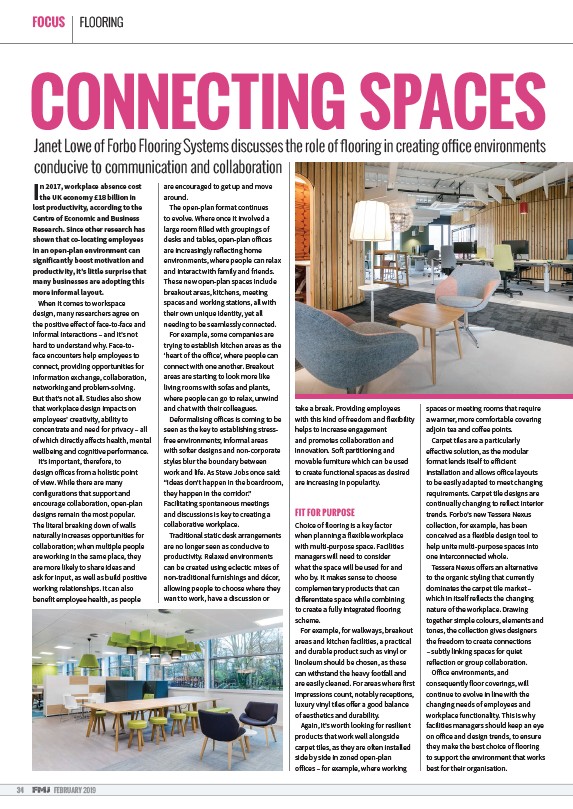
FOCUS FLOORING
CONNECTING SPACES
-anet /owe of Forbo Flooring Systems discusses the role of fl ooring in creating oƝ ce environments
conducive to communication and collaboration
In 2017, workplace absence cost
the UK economy £18 billion in
lost productivity, according to the
Centre of Economic and Business
Research. Since other research has
shown that co-locating employees
in an open-plan environment can
significantly boost motivation and
productivity, it’s little surprise that
many businesses are adopting this
more informal layout.
When it comes to workspace
design, many researchers agree on
the positive e ect of face-to-face and
informal interactions – and it’s not
hard to understand why. Face-toface
encounters help employees to
connect, providing opportunities for
information exchange, collaboration,
networking and problem-solving.
But that’s not all. Studies also show
that workplace design impacts on
employees’ creativity, ability to
concentrate and need for privacy – all
of which directly a ects health, mental
wellbeing and cognitive performance.
It’s important, therefore, to
design o ices from a holistic point
of view. While there are many
configurations that support and
encourage collaboration, open-plan
designs remain the most popular.
The literal breaking down of walls
naturally increases opportunities for
collaboration; when multiple people
are working in the same place, they
are more likely to share ideas and
ask for input, as well as build positive
working relationships. It can also
benefit employee health, as people
34 FEBRUARY 2019
are encouraged to get up and move
around.
The open-plan format continues
to evolve. Where once it involved a
large room filled with groupings of
desks and tables, open-plan o ices
are increasingly reflecting home
environments, where people can relax
and interact with family and friends.
These new open-plan spaces include
breakout areas, kitchens, meeting
spaces and working stations, all with
their own unique identity, yet all
needing to be seamlessly connected.
For example, some companies are
trying to establish kitchen areas as the
‘heart of the o ice’, where people can
connect with one another. Breakout
areas are starting to look more like
living rooms with sofas and plants,
where people can go to relax, unwind
and chat with their colleagues.
Deformalising o ices is coming to be
seen as the key to establishing stressfree
environments; informal areas
with so’ er designs and non-corporate
styles blur the boundary between
work and life. As Steve Jobs once said:
“Ideas don’t happen in the boardroom,
they happen in the corridor.”
Facilitating spontaneous meetings
and discussions is key to creating a
collaborative workplace.
Traditional static desk arrangements
are no longer seen as conducive to
productivity. Relaxed environments
can be created using eclectic mixes of
non-traditional furnishings and décor,
allowing people to choose where they
want to work, have a discussion or
take a break. Providing employees
with this kind of freedom and flexibility
helps to increase engagement
and promotes collaboration and
innovation. So’ partitioning and
movable furniture which can be used
to create functional spaces as desired
are increasing in popularity.
FIT FOR PURPOSE
Choice of flooring is a key factor
when planning a flexible workplace
with multi-purpose space. Facilities
managers will need to consider
what the space will be used for and
who by. It makes sense to choose
complementary products that can
di erentiate space while combining
to create a fully integrated flooring
scheme.
For example, for walkways, breakout
areas and kitchen facilities, a practical
and durable product such as vinyl or
linoleum should be chosen, as these
can withstand the heavy footfall and
are easily cleaned. For areas where first
impressions count, notably receptions,
luxury vinyl tiles o er a good balance
of aesthetics and durability.
Again, it’s worth looking for resilient
products that work well alongside
carpet tiles, as they are o’ en installed
side by side in zoned open-plan
o ices – for example, where working
spaces or meeting rooms that require
a warmer, more comfortable covering
adjoin tea and co ee points.
Carpet tiles are a particularly
e ective solution, as the modular
format lends itself to e icient
installation and allows o ice layouts
to be easily adapted to meet changing
requirements. Carpet tile designs are
continually changing to reflect interior
trends. Forbo’s new Tessera Nexus
collection, for example, has been
conceived as a flexible design tool to
help unite multi-purpose spaces into
one interconnected whole.
Tessera Nexus o ers an alternative
to the organic styling that currently
dominates the carpet tile market –
which in itself reflects the changing
nature of the workplace. Drawing
together simple colours, elements and
tones, the collection gives designers
the freedom to create connections
– subtly linking spaces for quiet
reflection or group collaboration.
O ice environments, and
consequently floor coverings, will
continue to evolve in line with the
changing needs of employees and
workplace functionality. This is why
facilities managers should keep an eye
on o ice and design trends, to ensure
they make the best choice of flooring
to support the environment that works
best for their organisation.